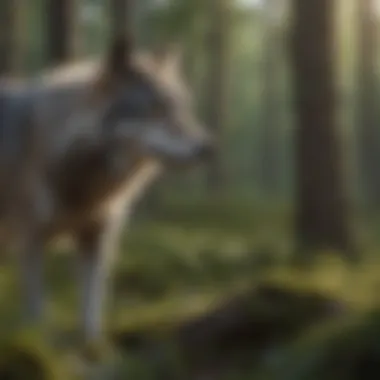Understanding the Timber Wolf: A Comprehensive Guide


Nature Topic Overview
The timber wolf, also known as the gray wolf, is a fascinating and vital part of nature. These animals live in various habitats, from forests to tundra, each adapted to survive in their environment. Their strong physiques, social structures, and hunting habits allow them to play a key role in the ecosystem. Understanding timber wolves helps us appreciate the balance of nature and the importance of wildlife conservation.
Timber wolves have thick fur that can vary in color, helping them blend into their surroundings. Their keen senses, particularly smell, enable them to detect prey from long distances. These traits make them effective hunters. Social creatures, wolves live in packs, where they establish strong bonds and share hunting duties. This social structure is essential for their survival.
Fun Facts and Trivia
- Timber wolves can weigh between 50 to 110 pounds, depending on their age and gender.
- A pack can consist of 2 to 20 wolves, typically led by an alpha male and female.
- Wolves can howl to communicate over long distances, ensuring the pack stays connected.
- They are highly territorial and will defend their area against other wolf packs.
Engaging with this type of information promotes curiosity about these animals. Using visuals like photos or infographics of packs in their habitat can enhance learning for young readers.
Wildlife Explorations
Timber wolves are a part of the Canidae family, which includes foxes, coyotes, and domestic dogs. Understanding their relatives provides context to their behaviors and habitats.
- Coyotes: Inhabiting diverse landscapes, coyotes are known for their adaptability. They often hunt alone or in pairs.
- Arctic wolves: This species lives in the colder Arctic regions and has unique adaptations for survival in extreme conditions.
- Red foxes: Smaller than wolves, these foxes are curious and known for their clever behaviors.
Exploring these related species shows the variety of life within habitats where timber wolves roam. Listening to recordings of wolf howls or engaging in animal matching games can foster further learning.
Environmental Awareness
Timber wolves hold significant ecological importance. They help maintain healthy ecosystems by controlling prey populations, which in turn benefits plant life and other animals. As top predators, when wolves are removed from an ecosystem, it can lead to overpopulation of herbivores, resulting in vegetation destruction.
To promote conservation, we can:
- Learn about the habitats of wolves and how to protect them.
- Support local wildlife organizations.
- Educate peers on the importance of predators in nature.
Young readers can understand that every effort counts in protecting these magnificent creatures and their environments.
DIY Nature Activities
Here are some fun activities to connect with nature and timber wolves:
- Create a Wolf Den: Use a cardboard box to build a den. Decorate it with natural items from your yard or park.
- Track Their Footprints: Go for a nature walk and try to identify animal tracks. Use clay or play dough to create impressions of tracks you discover.
- Craft Wolf Masks: Use paper plates and art supplies to design wolf masks. This can be both fun and educational.
Getting involved with nature through crafts and activities helps deepen understanding. Encourage outdoor explorations to see local wildlife and appreciate their habitats.
"Understanding the timber wolf is more than learning about an animal. It is about connecting with nature and respecting our role within it."
In sum, both the beauty and significance of the timber wolf offer a valuable opportunity for appreciation and conservation. By exploring their traits, habitats, and the importance of their existence, we can promote a deeper awareness of wildlife and our environment.
Preamble to Timber Wolves
Understanding timber wolves is essential for appreciating their role in the ecosystem and the intricacies of their biology. This section introduces the reader to the fundamental characteristics of timber wolves, laying the groundwork for deeper exploration in subsequent sections. By defining what a timber wolf is and discussing their geographical distribution, we can appreciate their adaptability and significance in various habitats.
Defining the Timber Wolf
The timber wolf, scientifically known as Canis lupus, is a subspecies of the gray wolf characterized by its large size, notable fur, and social behavior. Timber wolves are known for their strong pack dynamics, and they often roam in family groups that include a dominant breeding pair. This social structure is crucial for breeding and hunting, allowing the pack to work together effectively in finding food. Timber wolves have a varied diet, primarily preying on ungulates, smaller mammals, and even carrion. This flexibility in their feeding habits demonstrates adaptability, making them resilient in changing environments.
Geographical Distribution


Timber wolves are primarily found in North America, inhabiting regions across Canada, Alaska, and parts of the northwestern United States. They tend to prefer vast wilderness areas where they can roam freely and hunt effectively. Their range includes boreal forests, tundra, and mountainous regions. However, their presence has diminished in some parts due to habitat loss and hunting.
The current distribution of timber wolves serves as an important indicator of the health of their ecosystems. > "The timber wolf's habitat reflects ecological balance and biodiversity within its environment."
Physical Characteristics
Understanding the physical characteristics of timber wolves is essential for many reasons. First, their appearance is an important aspect of their identity and helps to differentiate them from other wolf species. Their adaptations are closely linked to their survival in various environments. Also, studying these characteristics can provide insights into their behavior, health, and ecological roles. This section will delve deep into the timber wolf's size, weight, fur patterns, and features, uncovering how these elements contribute to their adaptation and role in nature.
Size and Weight
Average Height
The average height of a timber wolf is typically between 26 to 32 inches at the shoulder. This height allows them to navigate through dense forests and open plains. It provides them with agility to escape predators and a strong stance for hunting. The timber wolf's height is beneficial for both stealth and speed. The height also enables them to reach higher ground, improving their vantage point when scanning for prey or threats.
Average Weight
Timber wolves generally weigh from 50 to 110 pounds, depending on the region and food availability. This weight range allows them to be powerful hunters while also maintaining endurance. Timber wolves that weigh more can take down larger prey, such as elk or deer, which are vital for their diet. However, excess weight can hinder their agility, especially in mountainous terrains. Achieving the right balance in weight is crucial for their survival.
Fur Color and Texture
Common Fur Patterns
Timber wolves have a diverse range of fur colors, which include gray, brown, and black, often with white or cream accents. This variety not only aids in camouflage but also plays a role in social recognition among pack members. The distinct fur patterns allow timber wolves to blend seamlessly into their habitats, whether in snowy regions or dense forests. The benefit of having varied patterns is significant as it offers them an advantage when stalking prey or avoiding danger.
Seasonal Changes
As seasons change, so does the fur of timber wolves. In winter, they develop a thicker, fluffier coat that provides insulation against cold temperatures. This seasonal change is crucial for their survival, allowing them to remain active hunters in harsh climates. In summer, their fur sheds to a lighter, shorter coat that helps with heat regulation. The seasonal adaptation not only ensures their comfort but also aids in maintaining their health.
Facial Features
Ears
Timber wolves possess erect, triangular ears that are sensitive to sounds in their environment. This ear structure allows them to detect the faintest noises made by potential prey. Well-formed ears are essential for hunting, as they can pick up on sounds that are not heard by other animals. The ability to hear well gives them a tactical advantage in the wild.
Eyes
The eyes of timber wolves are typically a bright yellow or amber color. These distinctive eyes not only enhance their night vision but also convey their emotions during interactions with other pack members. The keen eyesight is vital for spotting prey at dawn or dusk when they are most active. Thus, their eye structure contributes significantly to their hunting success.
Nose
A timber wolf's nose is large and equipped with numerous scent receptors. This advanced olfactory ability allows them to detect scents over long distances, aiding in tracking prey and identifying territories. With their strong sense of smell, timber wolves can find food and navigate their environment effectively. This characteristic is, therefore, a crucial part of their survival toolkit.
Body Structure
Tail Structure
The tail of a timber wolf serves multiple purposes, including balance and communication. It is bushy and can be raised or lowered to signal their mood to other pack members. The tail also plays a role in maintaining stability during running or turning quickly while hunting. This structural feature is fundamental for both social interactions and physical agility.
Leg and Paw Design
Timber wolves have long, powerful legs and large paws that are adapted for traversing different terrains. Their paws are equipped with fur between the pads for better grip and protection against cold surfaces. The strength and design of their legs allow them to cover great distances while hunting or patrolling their territory. The leg structure is critical for maintaining their stamina and speed in varied environments.
Behavioral Traits
Understanding the behavioral traits of timber wolves is crucial to appreciating their role in the ecosystems they inhabit. Their behaviors are not random; they serve specific functions that enhance survival and social structure. Wolves exhibit complex social interactions, hunting methods, and territorial habits. These traits can teach us about communication, cooperation, and the balance of nature.


Pack Dynamics
Hierarchy within the Pack
Timber wolves live in a structured social system known as a pack. The hierarchy within the pack is defined by dominance and submission. At the top are the alpha wolves, who lead and make decisions for the pack. This social order is essential as it reduces conflict and leads to organized hunting and caring for young.
The key characteristic of this hierarchy is stability. By having a clear social structure, the pack can operate efficiently. The alpha pair usually have the first choice of food and mates, ensuring the strongest genes pass on to the next generation. This structure proves beneficial for survival, as it avoids chaotic leadership struggles within the pack. Moreover, other wolves in the pack have clearly defined roles, such as scouts or caregivers, which allows them to work together effectively.
A unique feature of the hierarchy is its flexibility. While alphas hold authority, they can be challenged, especially by younger wolves. This adaptability can lead to enhanced genetic diversity when new leaders emerge. However, constant competition can also lead to stress, especially for lower-ranking members who may get less access to resources.
Roles of Pack Members
Every member of a timber wolf pack contributes to its overall success. The roles within a pack include the alpha pair, betas, and rank-and-file members. Each position has its own responsibilities that benefit the pack's dynamics. For example, the alphas supervise hunts and direct the pack, while betas help uphold the rules and can lead when the alphas are absent.
The key characteristic of these roles is collaboration. Each member works together to achieve common goals: hunting, protection, and pup rearing. The more defined the roles, the more effective the pack becomes. This organized teamwork increases the chances of a successful hunt and helps keep the young safe from predators.
A unique feature of pack roles is the mentorship among members. Older, more experienced wolves pass knowledge to younger ones, teaching them hunting skills and social interactions. This mentoring relationship strengthens pack bonds. While there are benefits, a disadvantage can be when a member does not find their role fulfilling, potentially leading to conflicts within the pack.
Hunting Techniques
Hunting is another key behavior of timber wolves that highlights their social skills. They employ specific techniques that are vital to their survival in the wild. Coordinated group efforts often allow them to tackle larger prey.
Cooperative Hunting
Cooperative hunting involves working as a team to bring down prey. This method is essential, as timber wolves primarily hunt large animals like elk or deer. By working together, they increase their chances of success and efficiency in hunting.
The distinct aspect of cooperative hunting is strategic coordination. Wolves communicate through body language and vocalizations to signal their plans. This behavior underlines the intelligence and social nature of timber wolves. Their teamwork allows them to pursue and tire out prey, which would be difficult for a single wolf to accomplish alone.
One advantage is that cooperative hunting ensures a higher success rate and, consequently, more food for the pack. However, this method also requires a higher degree of trust and connection among pack members. If communication fails, hunts can become disorganized, leading to missed opportunities.
Prey Selection
Prey selection is another critical factor in wolf hunting behavior. Timber wolves are opportunistic hunters and will choose prey based on availability, size, and the pack's collective ability to tackle it. This behavior reflects their adaptability in various environments.
A significant aspect of prey selection is the understanding of prey behavior. Wolves often observe and learn the habits of their target species. This characteristic allows them to make informed decisions on when and how to launch an attack. Having a robust understanding of their environment helps them exploit weaknesses in various prey.
A unique feature of prey selection is its impact on the ecosystem. By selecting certain animals, timber wolves help regulate prey populations, preventing overgrazing and promoting biodiversity. However, focusing too heavily on one type of prey can lead to disadvantages, such as scarcity if that species becomes endangered.
Timber wolves exemplify complex behavioral traits that reflect their intelligence, social cooperation, and ecological importance.
Habitat and Range
Understanding the habitat and range of the timber wolf is crucial for comprehending their behavior and survival. Timber wolves, being highly adaptable, thrive in various environments, but specific habitats suit their needs best. The information provided in this section will unveil how these habitats influence the timber wolf's life and the importance of conserving these areas.
Preferred Habitats
Timber wolves often select their habitats based on availability of prey, shelter, and breeding grounds. Two primary habitats, forests and grasslands, provide unique benefits and challenges.
Forests
Forests are a favored habitat for timber wolves. They offer dense foliage and ample cover, which is essential for hunting and nesting. The complexity of forest ecosystems supports a diverse range of prey, including deer, small mammals, and birds. This makes forests a beneficial choice for timber wolves. One unique feature of forests is their layered structure, which allows wolves to stalk prey effectively. The advantages of dense vegetation outweigh challenges such as human interference in these areas, making forests vital for the survival of timber wolves.
Grasslands


Grasslands present a different kind of habitat for timber wolves. These open areas are typically rich in herbivores, allowing wolves to employ their hunting strategies. Grasslands also provide clear sightlines which can be advantageous during a hunt. However, these habitats are more exposed, so wolves must adapt their hunting techniques to avoid becoming prey themselves. A significant key characteristic of grasslands is their biodiversity, which supports a variety of species. Although less dense than forests, grasslands still play a crucial role in maintaining the population of timber wolves by providing ample food sources.
Conservation Status
The conservation status of timber wolves highlights the urgent need for habitat protection. Many wolves face threats due to habitat destruction and climate change.
Threats to Habitat
Threats to habitat significantly impact timber wolves. Urban development, agriculture, and logging can lead to habitat loss, making it difficult for wolves to find food and shelter. The primary key characteristic of these threats is their often irreparable nature, which can destabilize entire ecosystems. Addressing these threats is critical for the survival of not only timber wolves but many other species that share their ecosystem.
Conservation Efforts
Conservation efforts play an integral role in protecting timber wolves. Organizations work tirelessly to establish protected areas and promote responsible land use. This initiative helps maintain habitats conducive to the survival of timber wolves. The unique feature of conservation programs is their ability to foster community involvement and awareness. This can lead to successful outcomes, ensuring that wolves and their habitats can thrive for generations.
Summary: Understanding the habitat and range of timber wolves allows us to appreciate the delicate balance within ecosystems. Protecting these habitats is necessary for the well-being of the timber wolf population, making conservation efforts paramount in their survival.
Cultural Significance
Cultural significance of the timber wolf can be found in various facets of human history, literature, and environmental importance. Timber wolves have captured the human imagination for centuries. They symbolize wilderness, freedom, and the untamed spirit of nature. Their role in stories and folklore has a profound impact on how humans relate to the natural world.
Symbolism in Literature and Folklore
Myths and Legends
Timber wolves appear prominently in myths and legends across many cultures. They often embody themes of loyalty, strength, and survival. For instance, many Native American tribes regard the timber wolf as a spiritual guide. In these narratives, wolves are often depicted as protectors and wise beings. Their presence in folklore serves to instill respect for nature and emphasize the interconnectedness of all living beings. These stories can teach lessons about cooperation and living harmoniously within one's environment. Therefore, myths and legends form a beneficial part of this article. They help convey values about nature.
Modern Representations
Contemporary representations of timber wolves also play a key role in shaping public perception. Movies and books often depict them as fierce, cunning, or misunderstood creatures. These portrayals can either promote admiration or fear. It is essential to explore these modern depictions. They reflect current societal attitudes toward wildlife and conservation. Understanding these representations can highlight the importance of fostering a more accurate view of timber wolves. They are not just icons of danger; they also symbolize ecological balance and family dynamics within their packs.
Role in Ecosystems
Predator-Prey Relationships
Predator-prey relationships are crucial for understanding the timber wolf's role in maintaining ecological balance. Timber wolves regulate populations of herbivores, such as deer. By controlling these populations, wolves help prevent overgrazing and promote biodiversity. This aspect of their ecology is vital for sustaining healthy ecosystems. Highlighting these relationships illustrates the timber wolf’s beneficial influence on nature. Without such predators, certain species could dominate an area unnecessarily, leading to habitat degradation.
Impact on Biodiversity
The impact of timber wolves on biodiversity is significant. By influencing the populations of other species, they indirectly support various plants and animal life. Their hunting strategies create opportunities for smaller predators and scavengers. This complex web of interactions fosters a rich and diverse environment. Recognizing the importance of timber wolves in promoting biodiversity helps to emphasize their essential role in ecosystems. It encourages conservation efforts and ensures the survival of both wolves and the habitats they help sustain.
Timber wolves are not only fascinating creatures; they are vital components of healthy ecosystems, serving as indicators of environmental health.
Ending
The conclusion of this article serves as a pivotal point that synthesizes the various aspects of the timber wolf. It reinforces the significance of understanding timber wolves not just from a biological standpoint, but also from a cultural and ecological perspective. By recognizing their physical traits, behavioral patterns, and the roles they play within ecosystems, readers can appreciate the complexity and beauty of these creatures.
Summary of Key Points
In this guide, we have covered several key topics regarding timber wolves:
- Physical Characteristics: We explored their size, fur patterns, and facial features. Understanding these helps in identifying timber wolves in their natural habitat.
- Behavioral Traits: The pack dynamics and hunting techniques demonstrate their social structure and survival strategies.
- Habitat and Range: Timber wolves thrive in various environments, including forests and grasslands. Awareness of their preferred habitats is crucial for conservation efforts.
- Cultural Significance: Timber wolves often symbolize strength and resilience in literature and folklore, providing insights into human perceptions of nature.
- Ecosystem Role: Their position as apex predators maintains the balance within their ecosystems, influencing the diversity of species.
"Timber wolves are essential to their ecosystems, regulating prey populations and enhancing biodiversity."
Encouraging Conservation
Conservation of timber wolves is vital for maintaining the ecological balance. Their existence affects many other species and the overall health of their habitats. Efforts must be made to protect them from threats such as habitat destruction and hunting. It is important for young learners and their caregivers to understand the value of these majestic animals and their role in the wild.
Parents, teachers and students can engage in local conservation programs or participate in educational activities that promote awareness about timber wolves. By fostering care for wildlife, we empower the next generation to become stewards of the environment. Supporting conservation organizations, sharing information, and advocating for responsible wildlife management can all contribute to saving timber wolves and ensuring that they continue to roam the earth for generations to come.







